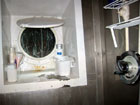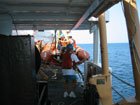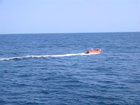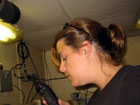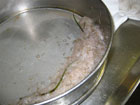

 | |||||||
|
|
Journals 2004/2005Aimee Gauthier
August 18, 2004 - Day 3 After a quick shower this morning I felt refreshed and ready to start my morning. This picture is a view from the porthole in the shower. (Click on thumbnail below for full version pop-up) John S. and I took over for John H. and Karen. They were just bringing back up the bongos. This had both the baby bongos (20cm in diameter) for ZOOGEN and the larger ECOMON bongos (61 cm). After preserving the samples, we have about 5 hours between stations. We will be steaming until the end of my watch. Steaming is simply moving along with any sampling. Jokingly, John S suggested that he chooses the stations well, so he has to do limited work, but actually the stations are chosen arbitrarily. A computer plots out where the stations will be. I guess we just have good luck. Today seems warmer, maybe a little muggier, but the sun has not come up yet. As I sit and write this, I see the magenta color of the sunrise reflects off the porthole cover- again GORGEOUS! As we wait for the next station, John showed me how to read the chart. I know how far away we are from our next destination without using the computer modules. I can use the dividers and determine our location based on the longitude and latitude - Very COOL. John is more a chart guy and depends less on the computer model. He thinks it is important to realize that if the GPS unit malfunctions, someone should know how to get back. I agree. The crew is now working on giving the boat a face lift. According to the winch and the crew they take the opportunity during a long steam, to remove the rust from the steel ship. It is quite loud, I am glad I am awake during this watch. The crew is really great. They all seemed to work a lot and take great pride in their ship. The next station was over 3 hours away and that would no longer be part of our watch. In the mean time I watched the XO, Kenny, Patrick, and Lino drop the safety raft into the water. I assume that it was an abandon ship drill and there is a time constraint. The XO (executive officer) said that at their last inspection that it was something that they need to work on. It was interesting to watch. There is so much that goes on this ship that I miss. (Click on thumbnails below for full version pop-up) August 18, 2004 - Day 3 Watch: 6pm - 12am Because of the spacing of the stations, I was not working so hard today I did not sleep a lot this afternoon. When 6 pm came around, I finally filtered some water for a Nitrogen sample. I filtered 1000 ml of water and when you looked at the filter paper, it was a greenish color. I assume that was the chlorophyll from the phytoplankton. At the next station, I worked the computer and I was in contact with Tony, the winch man, via the walkie talkie. Because of our communication he was able to lower the bongo nets into the water. (Click on thumbnail below for full version pop-up) The depth of the water was only 20 m, that is shallow, so we needed to change the rate of the wire that goes out into the water, so that we would have an approximately a 5 minute tow as usual. I needed to be extra cautious when watching the monitors to make sure that the CTD did not go any lower than the 15 m from the bottom, or then we would have a problem. The tow went fine, the bongo nets went down and then back up. He told me the amount of wire that went out and then I exited the program. John washed down the nets and I preserved the plankton specimens. Because we are so close to North Carolina's coast, so close that I could see the Bodi Lighthouse, the samples that were brought up were much different than before. The nets were covered with plankton and it was very difficult to spray down and even more difficult to collect at the bottom of the net. Once collected, tonight's samples were greenish brown and the consistency of tapioca. With in the jars there was something that looked like a blade of grass and more phytoplankton known as a dinoflagellate. (Click on thumbnail below for full version pop-up) The change in the plankton was due the close proximity to the shore. There was more phytoplankton fro two reasons: 1) light can penetrate the water more easily where it is shallower and 2) the nutrient run off from the shore is high. This allows for premiere phytoplankton growth. We completed the evening with two more uneventful tows and now we are heading north back towards Woods Hole. Return to Journals Index |
||||||
